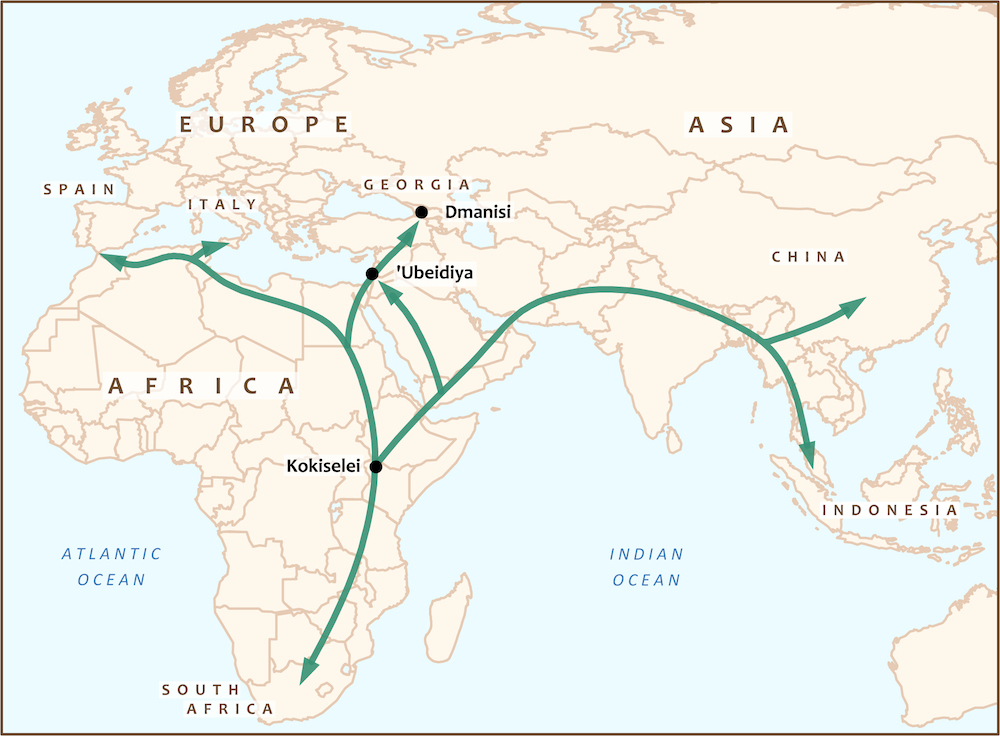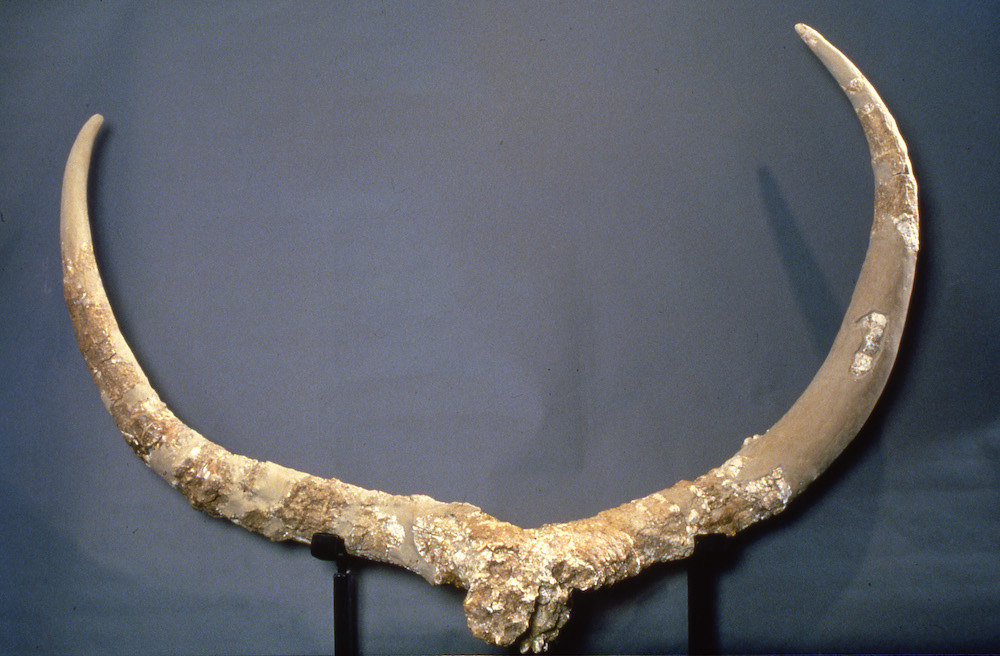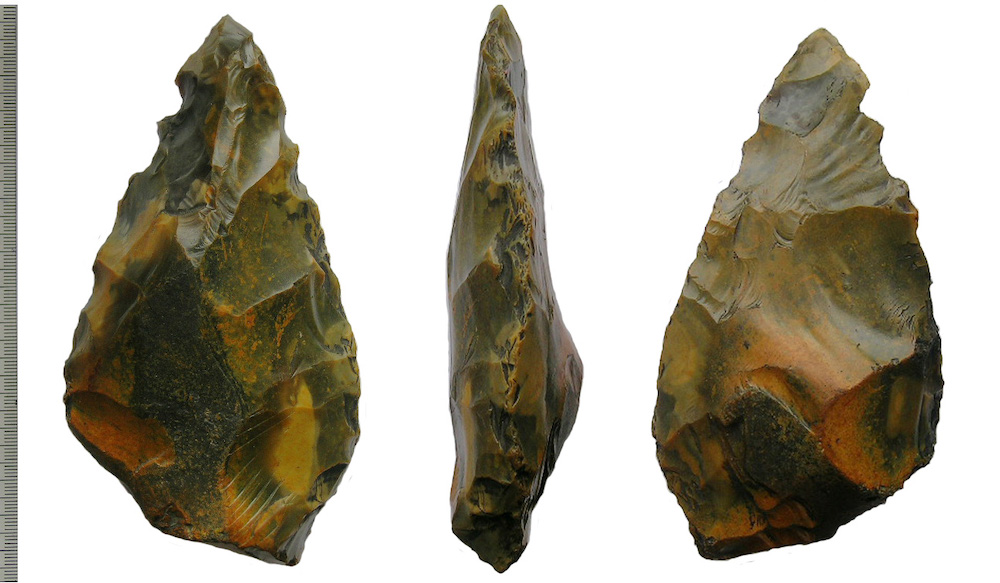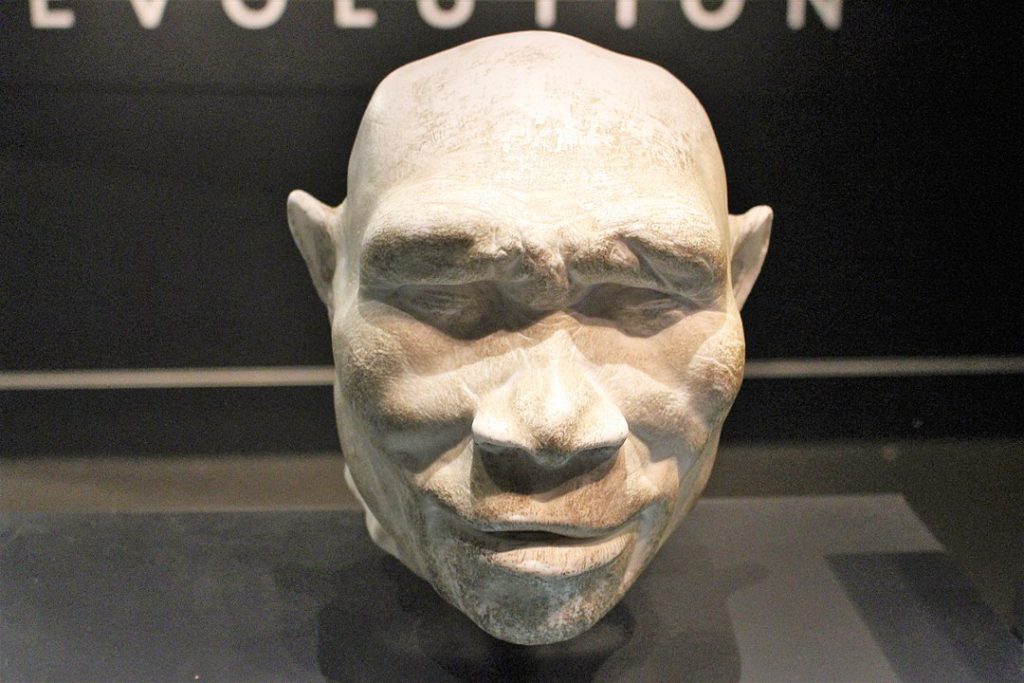What Drove Homo Erectus Out of Africa?

On a searing hot summer day at ‘Ubeidiya, an ancient site in northern Israel, an undulating expanse of dry grasses and thistles stretches into the distance. Far on the horizon, the mountains of Jordan shimmer through the haze; nearby stand cultivated olive groves and a date palm plantation.
Just south of the Sea of Galilee, and up a rocky dirt road, ‘Ubeidiya seems like a secret, with no sign to indicate its archaeological riches. About 1.5 million years ago, ‘Ubeidiya’s panorama would have looked dramatically different, says archaeologist Omry Barzilai, of the Israel Antiquities Authority, as he tramps through hillside brambles. “You would have seen a large lake that extends all the way to the Jordanian hills,” he says.
Hippopotami would have grazed on aquatic plants. The landscape was thickly wooded by wild oak, olive, and pistachio trees. And on the lakeshore, one might have glimpsed some of modern human’s relatives, a band of Homo erectus, using sharpened stone hand axes to rip up the carcass of a deer or hippo slaughtered by a saber-toothed tiger.
‘Ubeidiya is one of the earliest-known sites settled by H. erectus (sometimes called Homo ergaster) en route out of Africa. The ancient site—named after a nearby Palestinian Arab village and discovered in 1959 by members of a local farming collective, Kibbutz Afikim—may be key to understanding why H. erectus migrated from its place of origin.
What exactly pushed—or pulled—H. erectus out of Africa is a matter of fierce debate.
Was it some innate adaptability, such as social learning, curiosity, a taste for meat, or technological acuity? Did the expansion of grasslands or rapid changes in climate send them on their journey? Or was it some combination of these factors?
At stake are deep questions of resilience and innovation. As the paleoanthropologist Miriam Belmaker, of the University of Tulsa in Oklahoma, says, we need “to change the question from the ‘where, what, and when’ of the dispersal, to why was it successful.”
Known as H. erectus, this species is fascinating for its variety of “firsts.” Appearing in the fossil record about 2 million years ago, H. erectus was the first hominin to have relatively “human-like” proportions: taller than its predecessors, with longer legs and shorter arms.
Over the course of about 1.75 million years, they expanded into Western Asia, then into Eastern Asia, including what is today China and Indonesia. H. erectus, which means “upright man,” is also considered to be “the first runner,” says paleoanthropologist Andy Herries, of La Trobe University in Melbourne, Australia.
“Homo erectus is one of the most successful human species to have ever lived,” Herries says. “It seemingly evolved 2 million years ago, and if the recent dates from Indonesia are correct, it was still around 108,000 years ago.” Herries suspects modern humans might have a far shorter tenure on this planet due to human-induced climate change: “Homo sapiens, at 300,000 years [of existence so far], with its fossil fuels, can only dream of that length of time.”
H. erectus was also the first hominin—meaning, belonging to our ancestral human line—to make two-sided, teardrop-shaped stone hand axes, known as Acheulean tools, the earliest of which date back 1.7 million years. The abundance of tools and fossils found in Eastern Africa led most scholars to believe that H. erectus first evolved in that region’s Rift Valley. But a 2.04-million-year-old cranium, found by Herries in South Africa, indicates that these hominins were on the move 2 million years ago. H. erectus’ migrations within and out of Africa are astonishing in scope, and they eventually enabled the species to dwell across half the world.
On their way from Africa to Europe and Asia, H. erectus almost certainly traversed the Levantine Corridor, a narrow strip of territory between the Mediterranean Sea to the west and the desert to the east that includes present-day Syria, Lebanon, Israel, Palestine, and Jordan. The ‘Ubeidiya site, which H. erectus reached between 1.2 and 1.6 million years ago, was a way station en route through the Levant: not quite Africa, Europe, or Asia, but something in between.
For many years, scholars subscribed to the “Savannahstan” hypothesis to explain hominin journeys out of Africa. According to this idea, H. erectus dispersed out of East Africa about 2 million years ago as climate change triggered the expansion of East African savanna into the Southern Levant.
H. erectus likely stuck close to water sources—lakes and rivers—on their generations-long journey, says paleontologist Bienvenido Martínez-Navarro, of the Institut Català de Paleoecologia Humana i Evolució Social in Tarragona, Spain. As scavengers, they probably scraped meat off the carcasses of animals, particularly those killed by saber-toothed tigers. In essence, the original Savannahstan hypothesis suggests these hominins were so adapted to open grasslands and the occasional patch of woods that, as climate transformed environments, they trailed new savannas out of Africa.
But finds at ‘Ubeidiya have complicated the notion that H. erectus passively followed the spreading savanna. As Belmaker points out, ‘Ubeidiya wasn’t a savanna at all: It was a woodland, covered in trees, something her work has helped establish.
Evidence for Belmaker’s position is bolstered by hundreds of thousands of fossilized animal bones excavated at ‘Ubeidiya and mostly stored in drawers at the National Natural History Collections at the Hebrew University of Jerusalem. Among them are the teeth and bones of rhinoceroses, hippopotami, crocodiles, bears, pigs, camels, and a saber-toothed tiger. A short walk away, at the Israel Museum in Jerusalem, are the 6-foot-wide horns of an extinct buffalo species (the colorfully misnamed “monstrous sheep,” Pelorovis oldowayensis).
The majority of hoofed mammals found at ‘Ubeidiya were Eurasian, such as deer and elk, Belmaker explains, which indicates that the site was not an African savanna. And wear patterns on the molar teeth of extinct deer, giraffes, horses, and wild cattle suggest that these ungulates consumed soft leaves more characteristic of woodland vegetation rather than grassland.
Furthermore, Belmaker has compared the composition of carnivore fossils at ‘Ubeidiya and four other Eurasian hominin sites dating to the Early Pleistocene (between 2.6 million years ago and about 770,000 years ago). She determined that two of the H. erectus sites—Dmanisi in the country of Georgia and Pirro Nord in Italy—were inhabited by a wide diversity of animals, including hyenas and dog species, that favor open, long-distance running environments, meaning these sites were likely shrub or grassland. Meanwhile, three others—’Ubeidiya, Venta Micena in Spain, and Akhalkalaki in Georgia—featured a greater variety of ambush hunters, like felines, which rely more so on trees, suggesting the sites were forested.
Belmaker’s findings suggest H. erectus could thrive in more than one habitat type and was not limited to savannas. Building on this point, she has put forward a different theory of migration: H. erectus was innately adapted to a diversity of landscapes before groups even left Africa, both hunting antelope on open plains and scavenging in patches of forest.
Sites in Eastern Africa offer evidence that supports Belmaker’s hypothesis that H. erectus was well-equipped to thrive in a range of habitats. According to research by zoologist Isabelle Winder, now at Bangor University in Wales, the earthquake-prone African Rift Valley, where H. erectus evolved, would have had “rough” or irregular landscapes, rich in caves and basins that trapped water and sediments.
Not only did these spaces offer hominins places to forage and hide from predators, but the challenges associated with such disparate habitats would have meant that those individuals born with adaptations that improve their survival in multiple habitats—such as feet that act as levers, which help hominins clamber over boulders—would have been most likely to survive and reproduce. As a result, over the generations, H. erectus could have become more and more versatile.
“Homo erectus is one of the most successful human species to have ever lived,” says paleoanthropologist Andy Herries.
Such complex terrain, which is also found along coastlines, would have formed “plausible pathways” out of Africa that facilitated the expansion of early Homo, Winder says. These varied landscapes had hills, valleys, patches of forest and water, and diverse vegetation.
In addition, Belmaker believes H. erectus’ adaptations could have gone beyond physical abilities. She argues, “There was something special—either biologically, they were smarter, [or] they had social structure—that allowed humans to be successful in these novel environments.”
Belmaker points to a skull belonging to an ancestor of H. erectus from the 1.77 million-year-old Dmanisi site in Georgia for support. Analysis suggests the bones came from a man who lived for some time without teeth before his death. Though more than one scenario is possible, Belmaker argues this hominin likely survived because others cared for him, assisting with the hard work of gathering, hunting, and preparing raw meat and root vegetables—which would have to be mashed down for a man who could not chew.
These ideas radically reimagine the capacities of ancient hominins. “Homo erectus was not a passive creature in its environment,” Belmaker concludes. “It didn’t just go with the flow—’Oh, more grassland, I’ll move here’—but was an active factor in its own destiny. If they chose to live in woodlands, it means that they had some form of agency in their destiny, and that’s a very evolved animal.”
Other scholars agree that H. erectus was not simply following spreading savanna as the climate changed but rather had the capacity to adjust to a variety of environments.
“The course of human evolutionary history has been a ratcheting up of different abilities to occupy a variety of environments,” says paleoanthropologist Rick Potts, the head of the Smithsonian Institution’s Human Origins Program, “of eating a greater variety of foods, of being able to respond cognitively and socially to a wider variety of situations.”
He notes that by around 1.4 to 1.6 million years ago, H. erectus was occupying tropical Southeast Asia and Indonesia. “That also by itself is an indicator that it’s not just one type of habitat that is being followed.”
But Potts believes there was an urgent trigger that spurred adaptations: periods of highly variable climate.
Since the 1980s, Potts has been pondering the idea that climate variability relates to major evolutionary changes. In periods of rapid and sustained climatic change, he postulates, only individuals with certain traits will survive, thrive, and raise children, who in turn can carry those beneficial traits, shaping human evolution.
For example, cognitive abilities that enable individuals to make sophisticated stone tools could have allowed their users to consume varied foods across environments. And a trait like curiosity might have pushed hominins to move to more humid climes when the landscape dried.
“Homo erectus didn’t have a map,” Potts stresses. “They didn’t know they were out of Africa. They were just going over into the next valley to see what was there.” Over generations, their traversal of multiple hills and valleys would have led to dispersal.
In 2015, Potts co-published a paper in the Journal of Human Evolution in which he looked across several hominin species for signs that variability in the climate favored the evolution of beneficial traits. Together with anthropologist Tyler Faith, now at the University of Utah, the pair mapped periods of high and low climate variability for tropical Eastern Africa over the past 5 million years, specifically looking at once-every-100,000-year shifts in the Earth’s orbit that prompt more frequent switches between periods of drought and high rainfall. Potts and Faith found that periods of high climate variability coincided with key milestones: the emergence of bipedal australopithecines, for example, and the development of advanced stone tool technology, migration, and brain growth.
Several major hominin milestones, including the dispersals of H. erectus and H. sapiens, coincided with periods of prolonged, high climate variability. The pattern was so clear, Potts says, “It looks rigged.”
How might climate variability have shaped H. erectus? Marine geologist and climate scientist Peter de Menocal, the director of the Woods Hole Oceanographic Institution in Massachusetts, has studied changes in climate 1.9 million years ago using layers of sediment buried beneath the ocean floor off the coast of East Africa. He points out that “the period of around 2 million years [ago] is one of the major junctures in human evolution.”
Many adaptations emerged, de Menocal says, including the lithe bodies and longer legs that gave H. erectus a greater capacity for long-distance running or walking. Wider access to meat on the savanna could have supported the energy demands of their now-larger brains, and the increase in higher brain functioning presumably “led to a greater ability to plan and to coordinate and communicate,” he says.
“The making of us was fundamentally tied to changes in the environment,” says climate scientist Peter de Menocal.
One important H. erectus innovation that first appears in the fossil record 1.76 million years ago—at Kokiselei near Lake Turkana in Kenya—are bifacial Acheulean axes, which are far more advanced than earlier hominin tools. The cognitive and physical adaptations that supported this tool’s use may also relate to intense climatic change. In 2020, Rachel Lupien, a postdoctoral research scientist at the Lamont-Doherty Earth Observatory at Columbia University, used chemical signatures in plant leaf waxes preserved in the sediments of the Turkana Basin to identify a sudden shift in climate—from arid to humid and rainy—that roughly coincides with the rise of this technology.
“Acheulean hand axes were well-suited for rapid environmental changes because they were more of a multipurpose tool,” Lupien says, and that allowed H. erectus to thrive in multiple environments.
Lupien believes both innate adaptability and rapid climate change could have enabled H. erectus’ dispersal out of Africa. But climate variability, she emphasizes, likely played a significant role: “I’ve seen really large climate swings coinciding with the most up-to-date dates on these transitions, and that coincidence, I think, is not random.”
There are still some scholars who argue for a variation on the Savannahstan hypothesis, presenting savanna as a combination of grassland and some woodland. But for many people debating H. erectus’ journeys out of Africa, the question is no longer whether H. erectus was adaptable to different landscapes, but rather what drove this hominin’s flexibility.
Belmaker admits that Potts’ hypothesis shows “nice” correlations between climate shifts and the emergence of new adaptations. The problem, she says, is that for each long period of rapid climate variability, each individual generation of H. erectus would have experienced the climate as fairly constant. As a result, she doubts climate change would have significantly driven the passing of traits from one generation to the next.
Belmaker further argues that many of the significant milestones that Potts believes coincided with climate change emerged far earlier. Stone tools date back 3.3 million years, for example, well before H. erectus appeared on the scene.
Instead, Belmaker suspects that adaptability was already part of this hominin’s ancestral makeup. “They were successful, in my opinion,” she says, “because they were generalists, and because they had social relationships.”
But others, like de Menocal, remain convinced that “the making of us was fundamentally tied to changes in the environment.” Furthermore, he argues, “owning that as your origin story carries with it this really deep lesson for the future,” particularly as we H. sapiens confront our own, human-induced climate change.
“We’re smart. In our best selves, we’re adaptable to change, and we make smart decisions based on these existential threats that these changes pose to us,” de Menocal says. “Our history is one of adapting to those big changes. So, the larger takeaway on this is that we have to pay attention to the threat.”
This article was republished at The Atlantic.
Update: In February 2022, Miriam Belmaker and her colleagues announced that a hominin vertebra found in ‘Ubeidiya dated back 1.5 million years, strengthening the case for multiple waves of hominin species migrating out of Africa.




































